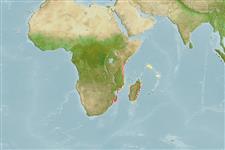>
Centrarchiformes (Basses) >
Oplegnathidae (Knifejaws)
Etymology: Oplegnathus: Greek, hoplon = weapon + Greek, gnathos = jaw (Ref. 45335).
Eponymy: Peão Lopes of the Lourenco Marques Museum was described as “…a most able collector and technician”. He collected eight of the records of fishes in or near Delagoa Bay that Smith discussed in his paper, presumably including the knifejaw holotype. (Ref. 128868), visit book page.
More on author: Smith.
Environment: milieu / climate zone / depth range / distribution range
Écologie
marin récifal; profondeur 20 - 130 m. Tropical
Western Indian Ocean: Delagoa Bay in Mozambique northwards (Ref. 4387), but the northern limit of its range in not known (Ref. 9660).
Taille / Poids / Âge
Maturity: Lm ? range ? - ? cm
Max length : 75.0 cm TL mâle / non sexé; (Ref. 9660); common length : 50.0 cm TL mâle / non sexé; (Ref. 9660)
Description synthétique
Clés d'identification | Morphologie | Morphométrie
Épines dorsales (Total) : 11; Rayons mous dorsaux (Total) : 20 - 21; Épines anales: 3; Rayons mous anaux: 16. Adults dark bronzy brown in color.
Inhabits reef areas and feeds on benthic invertebrates.
Life cycle and mating behavior
Maturité | Reproduction | Frai | Œufs | Fécondité | Larves
Heemstra, P.C., 1984. Oplegnathidae. In W. Fischer and G. Bianchi (eds.) FAO species identification sheets for fishery purposes. Western Indian Ocean (Fishing area 51). Vol. 3, FAO, Rome. (Ref. 9660)
Statut dans la liste rouge de l'IUCN (Ref. 130435: Version 2024-2)
Menace pour l'homme
Harmless
Utilisations par l'homme
Pêcheries: commercial
Outils
Articles particuliers
Télécharger en XML
Sources Internet
Estimates based on models
Preferred temperature (Ref.
123201): 22.9 - 26.6, mean 25.6 °C (based on 16 cells).
Phylogenetic diversity index (Ref.
82804): PD
50 = 0.5156 [Uniqueness, from 0.5 = low to 2.0 = high].
Bayesian length-weight: a=0.01995 (0.00906 - 0.04395), b=3.01 (2.83 - 3.19), in cm total length, based on all LWR estimates for this body shape (Ref.
93245).
Niveau trophique (Ref.
69278): 3.5 ±0.37 se; based on food items.
Fishing Vulnerability (Ref.
59153): Moderate to high vulnerability (50 of 100).
